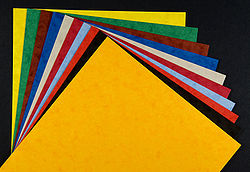- Card stock
-
Card stock, also called cover stock or pasteboard, is a paper stock that is thicker and more durable than normal writing or printing paper, but thinner and more flexible than other forms of paperboard. Card stock is often used for business cards, postcards, playing cards, catalog covers, scrapbooking, and other uses which require higher durability than regular paper. The texture is usually smooth, but can be textured, metallic, or glossy.
Card stock thickness is often described by pound weight. Pound weight is the weight of 500 sheets of 20 by 26 in (508 by 660 mm) paper. This differs from how text stock is determined, which assumes 500 sheets of 25 by 38 in (635 by 965 mm) paper. Most countries use the term grammage to describe the weight of the paper in grams per square metre. The term card stock is used to describe paper with weights from 50 lb to 110 lb (about 135 to 300 g/m²).
In the U.S., card stock thickness is usually measured in points or mils that gives the thickness of the sheet in thousandths of an inch. For example, a 10 pt. card is 0.010 in (0.254 mm) thick (roughly corresponding to a weight of 250 g/m2); 12 pt. is 0.012 in (0.3048 mm).
Approximate conversions
Poundage, or grammage, refer to the weight of the paper, and points refers to its actual thickness. This being the case there is no absolute conversion from pounds or grams per square metre (g/m²) to pts as paper density may vary slightly. The following table shows the approximate conversion values.
Single-sided coating Double-sided coating pt g/m² lb pt g/m² lb 6 148 55 6 166 60 8 184 70 8 201 75 10 219 80 10 237 88 12 247 90 12 265 98 14 274 100 14 293 108 See also
References
Categories:- Printing terminology
- Paper
- Materials stubs
Wikimedia Foundation. 2010.

